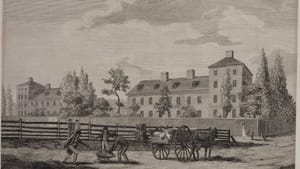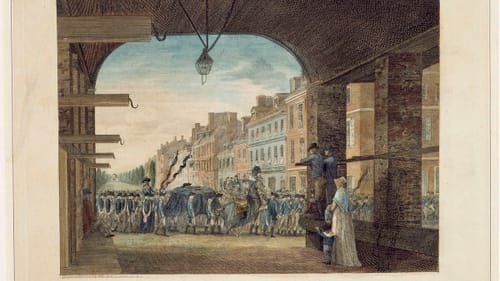Stay in the Loop
BSR publishes on a weekly schedule, with an email newsletter every Wednesday and Thursday morning. There’s no paywall, and subscribing is always free.
Picturing Philadelphia
'William Birch, Ingenious Artist: His Life, His Philadelphia Views, and His Legacy'

When Philadelphia was America’s political and cultural capital, images drawn by British émigré William Russell Birch (1755-1834) introduced the city to itself and to the world. According to the Library Company of Philadelphia (LCP) exhibit William Birch, Ingenious Artist: His Life, His Philadelphia Views, and His Legacy, Birch provided “the fullest and most authentic picture of life in and around any city in early America.”
Birch’s book The City of Philadelphia in the Year 1800 was the first volume of color engravings published in the United States. It would make the enamel painter, who settled in Philadelphia in 1794, one of the most important artists of the Federal period. With his son Thomas (1779-1851), Birch published updates in 1804, 1809, and 1828.
In them, he recorded views of public spaces and buildings, mostly between the Delaware River and 11th Street — then the heart of the city. The Birch images circulated widely as individual lithographs, miniature enamels, and decorative items, such as earthenware plates and porcelain vases.
They became so well-known that they represented not just Philadelphia in the public mind, but all American cities. Yet the images are hardly generic.
Details humanize scenes, preserve history
Birch called himself a “copyist,” often replicating others’ work. Upon arriving in the United States, he built a reputation by recreating Gilbert Stuart’s portraits of George Washington. The technique allowed him to earn a living, but it also taught him to repurpose his own images for those who couldn’t or wouldn’t purchase a book of illustrations.
Whether it was a keen sense of subject, a talent for composition, or just luck, Birch opened a keyhole into a past that could easily have been lost. The Second Philadelphia Almshouse and House of Employment, for instance, would eventually be demolished — but lives on in “Alms House in Spruce Street,” 1799.
Here, Birch shows not only the structure and its walled backyard but a slice of early American life: three men surround a runaway pig, observed by bystanders and a couple of sheep. The figures are small and at the periphery. They’re easy to miss. Birch often incorporated tiny dramas and humor in the margins, likely a remnant of his early work creating satirical engravings.
Alms House gives the impression that the artist just happened by and pulled out a sketchbook. Perhaps he did — from the examples on view, it seems the details are often consistent from sketch to final vision.
{photo_2}
Birch's approach in “Back of the State House, Philadelphia” (1827-1828) is equally casual and more informative. It shows an oddly stunted Independence Hall waiting for a replacement steeple — the first had rotted — and, in the courtyard, a delegation of Native Americans conversing.
The title gives no hint of the importance of “High Street, from the Country Marketplace, Philadelphia” (1804). The engraving captures the national funeral of George Washington, which wasn’t a funeral at all. Washington died and was buried at his Virginia plantation, Mount Vernon, in December 1799. However, deep mourning for the first president inspired several mock funerals. The one in Philadelphia, then the capital, featured a cortege with an empty casket, riderless horse, military guard, congressional attendees, and honorary cannon fire.
Marketing his work
In Birch’s time as now, artists had to be concerned with sales. The exhibition includes a rare prospectus Birch prepared for Les Délices de la Grande Bretagne (1791), the book that established his reputation in Great Britain. The prospectus was issued with the first 15 plates, earning 240 subscribers and funding for the project. The finished volume contained 36 views and descriptions by the artist.

Of one view, from the home of his patron Sir Joshua Reynolds, Birch wrote of “the crystalline transparency of the stream, with the boldness and breadth of line, its elegancies of building embosomed in wood, and the distant hills tinged with the soft blue of the purest air.”
Obviously, Birch’s ability with pen and ink extended beyond drawing. He eventually partnered with Reynolds to make and sell enameled miniatures, explaining that while oils would fade, enamels would last.
Raising awareness of landscapes
In The Country Seats of the United States (1808), a U.S. counterpart to Délices, Birch continued to celebrate landscape design and applied what he learned at Springland, his four-acre property along the Neshaminy Creek in Bucks County. The show includes his watercolor plans for a studio, a lodge for his art collection, a grotto, a water garden, and a circular drive, as well as practical features like a granary, a hen house, and a pigsty. Birch lost the property to creditors in 1805 but regained it in 1813.
Though Country Seats was less commercially successful than The City of Philadelphia, it affected Americans’ thinking about their surroundings. Those with large properties began to consider framing views through the placement of plantings and accent structures (or "follies"). Even for those of modest means, scenic lithographs and decorative objects provided a glimpse of nature.
Birch aspired to cultivate artistic taste through his art, but he ultimately gave America a more precious gift: irreplaceable snapshots of daily life in a new nation and its preeminent city.
What, When, Where
William Birch, Ingenious Artist: His Life, His Philadelphia Views, and His Legacy. Through October 19, 2018, at the the Library Company of Philadelphia; 1314 Locust Street, Philadelphia. (215) 546-3181 or librarycompany.org.
Sign up for our newsletter
All of the week's new articles, all in one place. Sign up for the free weekly BSR newsletters, and don't miss a conversation.
